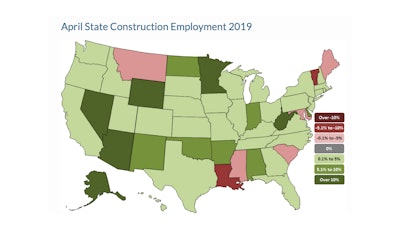
Forty-three states added construction jobs between April 2018 and April 2019, while construction employment increased in 32 states and the District of Columbia from March to April, according to an Associated General Contractors of America (AGC) analysis of Labor Department data. Association officials said the strong gains show demand for workers remains robust, and they urged federal officials to enact immigration reforms to boost the supply of qualified workers.
“Construction employment rose in most states over the past year, yet the record number of job openings at the end of March implies contractors would add even more workers if they could,” stated chief economist Ken Simonson. “The count of states with rising construction employment in the latest month would be still higher if more workers were available.”
Texas added the most construction jobs over the year (32,500 jobs, 4.4%), followed by:
- Florida (22,600 jobs, 4.2%)
- Arizona (19,800 jobs, 12.7%)
- California (19,000 jobs, 2.2%)
West Virginia added the highest percentage of construction jobs over 12 months (33.7%, 12,200 jobs), followed by:
- Nevada (14.6%, 13,000 jobs)
- Arizona (12.7%, 19,800 jobs)
- Alaska (12.3%, 1,900 jobs)
- Wyoming (11.8%, 2,300 jobs)
- Minnesota (11.4%, 13,100 jobs)
Construction employment reached a record high in four states: Massachusetts, Oklahoma, Oregon and Texas.
Seven states and the District of Columbia shed construction jobs over the latest 12 months. The largest job loss took place in Louisiana (-8,400 jobs, -5.5%) followed by:
- South Carolina (-3,600 jobs, -3.5%)
- Mississippi (-1,800 jobs, -4%)
Vermont had the steepest percentage decline in construction jobs over the 12-month span (-7.2%, -1,100 jobs) followed by:
- Louisiana (-5.5%, -8,400 jobs)
- Maine (-4.1%, -1,200 jobs)
- Mississippi (-4%, -1,800 jobs)
- South Carolina (-3.5%, -3,600 jobs)
Illinois added the most construction jobs between March and April (7,500 jobs, 3.3%) followed by:
- Texas (5,800 jobs, 0.8%)
- Missouri (3,400 jobs, 2.8%)
- Arizona (3,000 jobs, 1.8%)
Iowa added the highest percentage of construction jobs for the month (2.4%, 2,600 jobs) followed by:
- Illinois (3.3%, 7,500 jobs)
- Arkansas (2.8%, 1,400 jobs)
- Missouri (2.8%, 3,400 jobs)
Construction employment decreased from March to April in 15 states and was unchanged in Alaska, South Dakota and Vermont. Wisconsin lost the most construction jobs for the month (-2,400 jobs, -1.9%) closely followed by:
- Connecticut (-2,300 jobs, -3.7%)
- West Virginia (-2,100 jobs, -4.2%)
West Virginia, Connecticut and Wisconsin also had the steepest percentage losses of construction jobs between March and April.
Association officials said the record number of job openings in construction underscores the urgency of enacting immigration reforms that would enable contractors to bring qualified guest workers into the country, along with strict safeguards for American jobs and reduced incentives for individuals to enter the country illegally. They called on Congress and the president to include construction trades that are in short supply in urgently needed immigration reform legislation.
“Contractors face an ever-increasing challenge to find enough qualified workers to hire to keep pace with the ongoing demand for construction,” said Stephen E. Sandherr, the association’s chief executive officer. “Allowing employers to bring in guest workers for positions that can’t be filled otherwise is essential for keeping needed construction on track.”


















